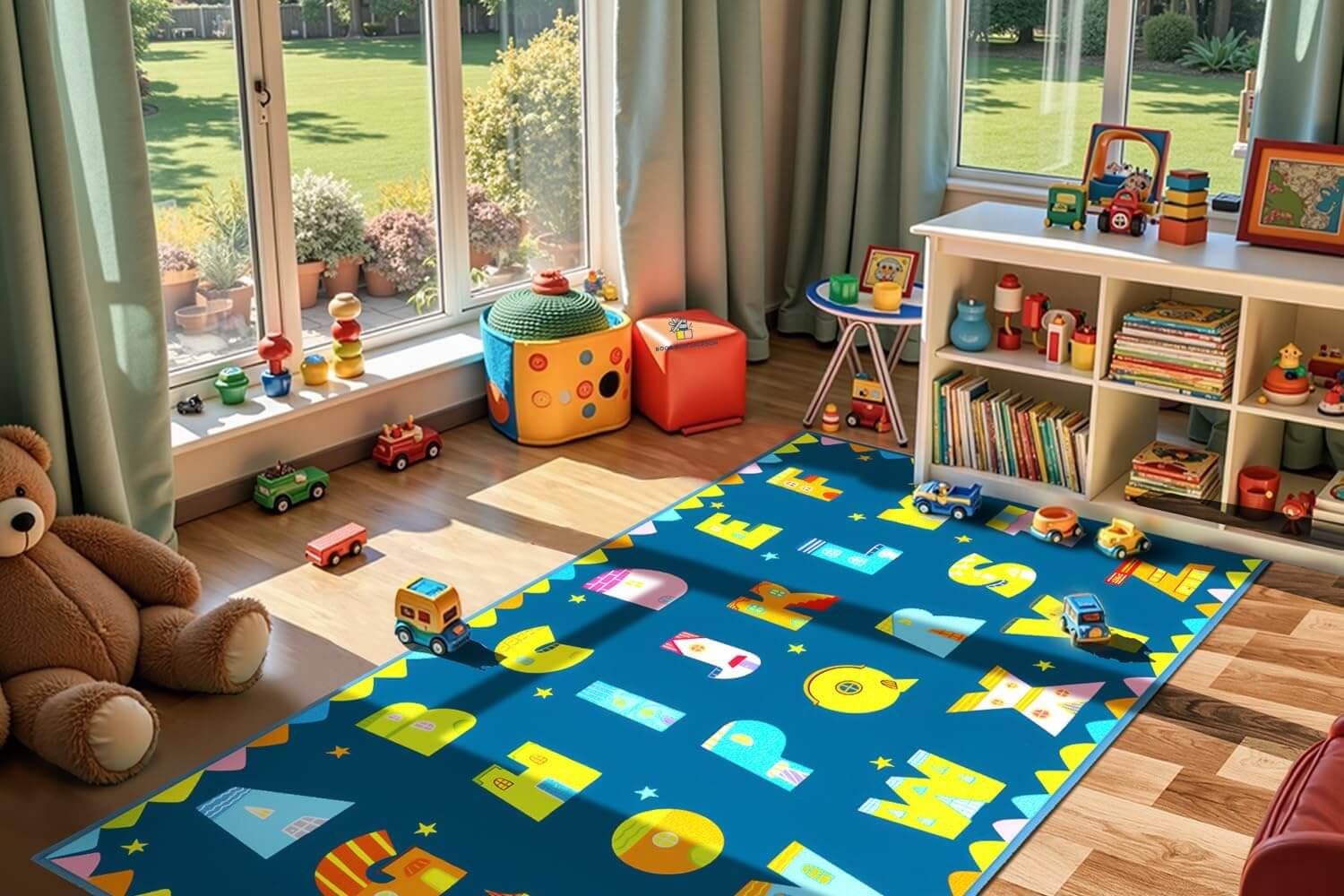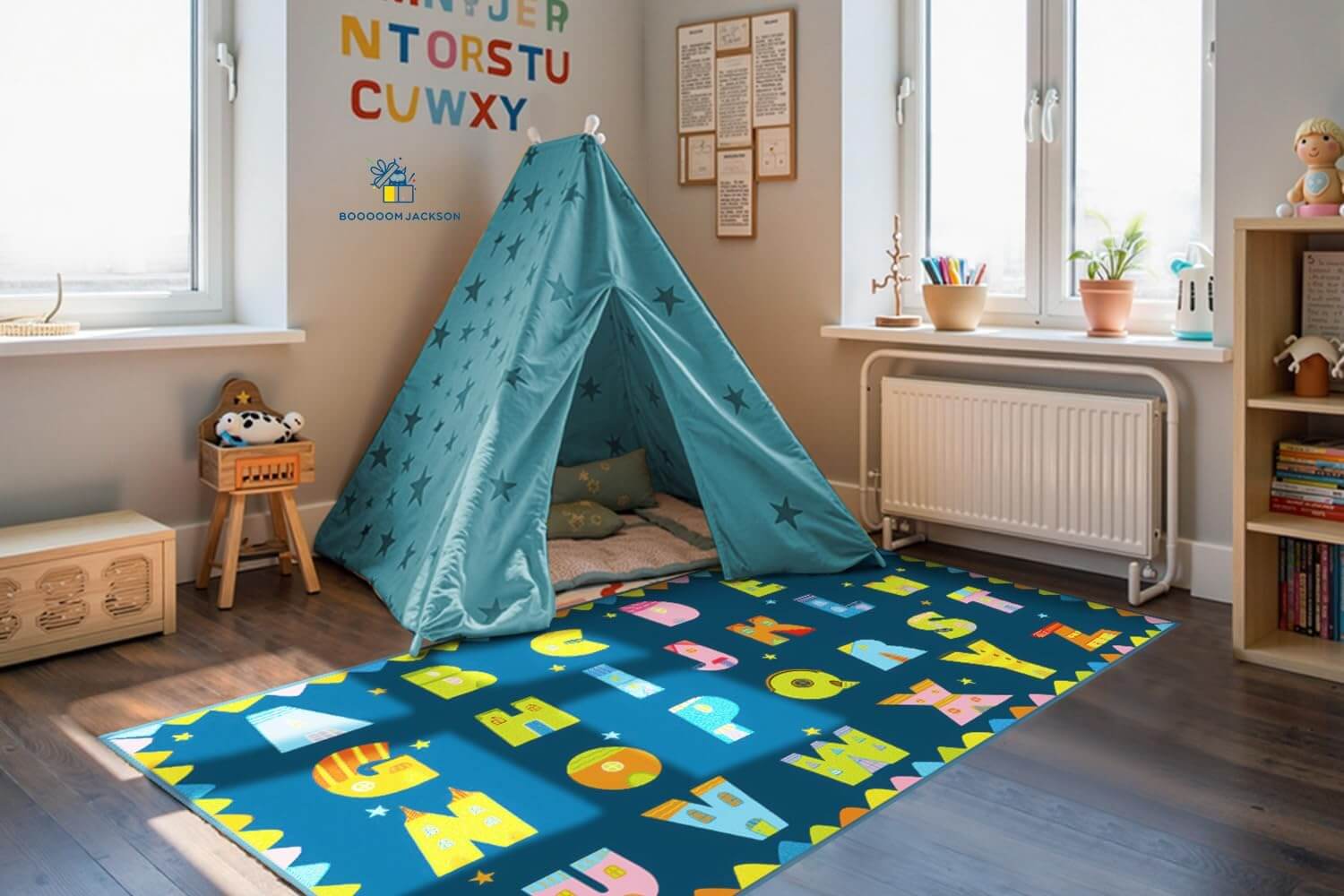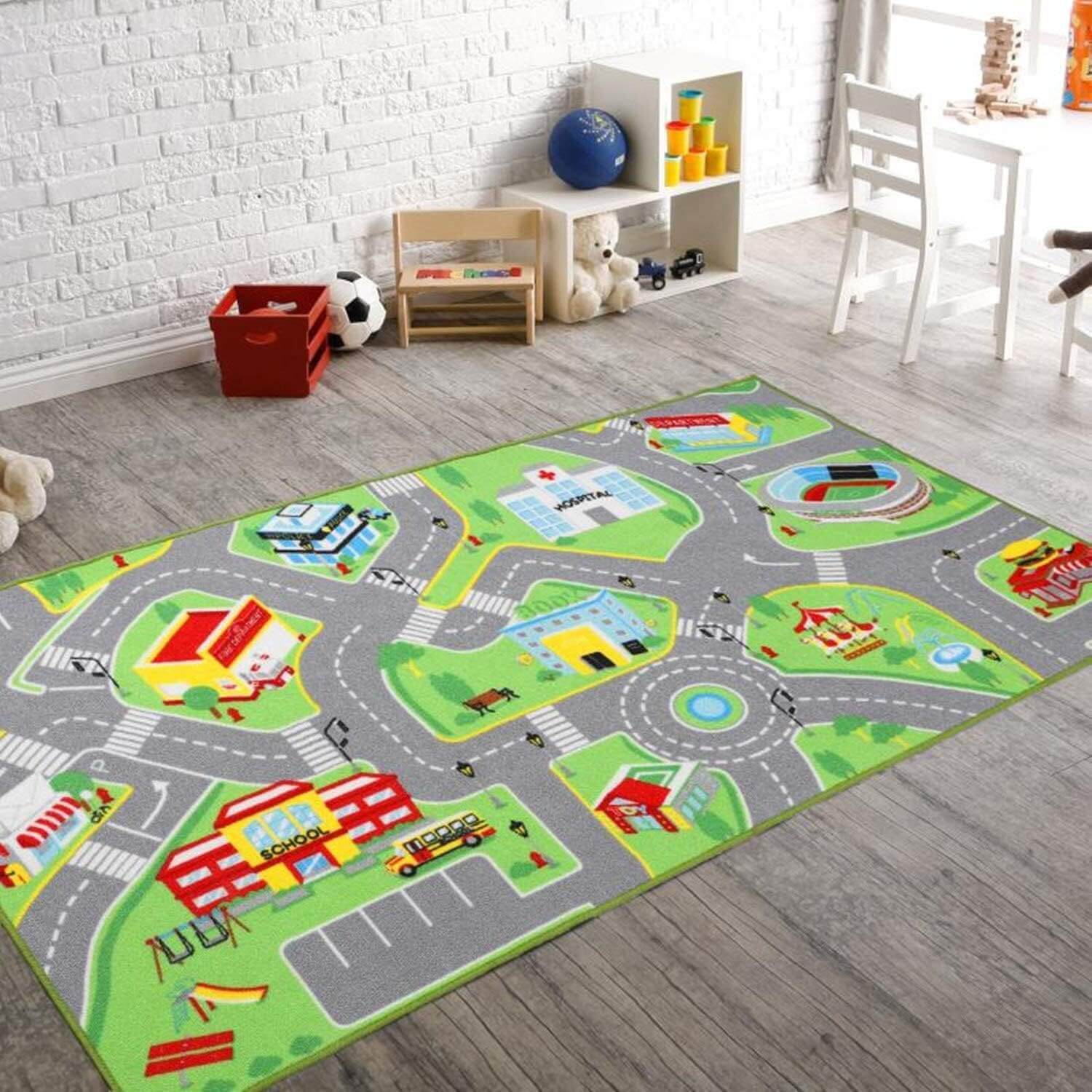Raise your hand if you've ever told a wiggly first-grader to "sit still and pay attention!" (Don't worry, we've all been there!) Now, imagine a classroom where that natural wiggliness isn't just tolerated but actually channeled into learning through cleverly designed floor coverings. Welcome to the wonderful world of interactive classroom carpets!
At BooooomJackson, we've been watching a quiet revolution unfold as teachers discover the magical connection between physical movement and brain development. These aren't your mama's classroom rugs with simple alphabet borders—they're sophisticated learning tools disguised as super-fun floor adventures!
When Floors Become More Than Just Something to Walk On
Traditional classroom carpets served a simple purpose: defining a gathering space and maybe featuring some basic ABCs around the border. But today's interactive carpet designs are active learning partners that recognize a fundamental truth about child development: little bodies need to move to learn!
According to research on movement in education, physical activity directly enhances cognitive function. Or as Ms. Rodriguez, a veteran kindergarten teacher, puts it: "When those little feet are moving, those little brains are grooving!"
Sensory Paths: When Walking Becomes Learning
Sensory paths—those colorful, patterned pathways that guide children through specific movements—have exploded in popularity for good reason. Originally developed for occupational therapy settings, these structured movement opportunities are now mainstream classroom features.
"Our BooooomJackson Sensory Explorer Carpet has completely transformed our transition times," shares first-grade teacher Mr. Washington. "Instead of chaotic line-up routines, my students now follow the sensory path—hopping on numbered lily pads, tiptoeing along the balance beam section, and doing quick cross-body movements at each station. They arrive at their next activity focused and ready to learn."
The science behind sensory paths is fascinating. According to occupational therapy experts, these movement sequences help:
- Integrate primitive reflexes
- Develop cross-lateral brain connections
- Release excess energy
- Rebuild focus and attention
- Calm overactive nervous systems
Popular Sensory Path Elements That Shine on Classroom Carpets
Not all sensory paths are created equal! The most effective interactive carpet designs incorporate:
1. Cross-Midline Movements
Patterns that require students to reach across their body's midline:
- Diagonal hopscotch grids
- Alternating hand-to-knee touches
- Figure-eight crawling paths
"The figure-eight pattern on our BooooomJackson Brain Booster Rug is a game-changer for my students with reading challenges," explains special education teacher Ms. Chen. "That simple movement pattern helps develop the cross-hemisphere brain connections needed for reading fluency."
Reading specialists confirm that these cross-lateral movements significantly impact reading development by strengthening corpus callosum connections.
2. Balance Challenges
Elements that develop proprioception and vestibular awareness:
- Narrow "balance beam" paths
- Stepping stone patterns
- Heel-to-toe walking sections
"The balance beam section of our interactive carpet has been particularly beneficial for my students who struggle with attention," notes second-grade teacher Mr. Patel. "That 30-second balance challenge seems to reset their focus in a way no verbal redirection ever could."
According to research on balance and cognition, these movements activate the cerebellum, which plays a crucial role in both physical coordination and cognitive processing.
3. Counting and Calculation Paths
Movement sequences that incorporate mathematical thinking:
- Skip-counting hopscotch
- Addition/subtraction stepping stones
- Multiplication movement maps
Kindergarten teacher Ms. Jackson shares: "Our BooooomJackson Math Mover Carpet has these brilliant number paths where students physically hop the skip-counting patterns. I've watched students who struggled with counting by 5s suddenly master it when their bodies became part of the learning process."
This integration of physical movement with mathematical concepts aligns with research on embodied cognition, which suggests that our thought processes are deeply influenced by physical experiences.
Learning Maps: When Geography Meets Movement
Beyond sensory paths, interactive carpet designs now include sophisticated learning maps that transform abstract concepts into physical experiences:
1. Continental Adventures
Carpets featuring world map designs with interactive elements:
- Animal tracking across different continents
- Climate zone hopping games
- Cultural exploration stations
"Our BooooomJackson World Explorer Carpet turned our geography unit from boring to brilliant," explains third-grade teacher Ms. Thompson. "Students physically travel between continents, stopping at challenge points to share facts or answer questions. The movement makes the learning stick in ways our previous paper maps never could."
Geography education specialists emphasize that physical interaction with spatial concepts significantly enhances geographical understanding.
2. Historical Timeline Tracks
Interactive carpets with historical journey elements:
- Era-based movement paths
- Historical figure hopping stations
- Chronological stepping stones
"The timeline track on our classroom carpet has transformed how we teach history," shares fifth-grade teacher Mr. Rodriguez. "Students physically step from era to era, acting out key moments at each station. The physical movement creates memory anchors that help students recall historical sequences with remarkable accuracy."
According to history education researchers, this embodied approach to chronological thinking builds stronger temporal understanding than traditional timeline activities.
3. Literary Journey Paths
Story-based interactive elements:
- Character development stations
- Plot structure pathways
- Genre-hopping games
"The story path on our BooooomJackson Narrative Navigator Carpet has become a cornerstone of our writing program," explains fourth-grade teacher Ms. Taylor. "Students physically move through the story structure—starting at the introduction stepping stones, jumping to the rising action lily pads, balancing along the climax beam, and so on. Their understanding of narrative structure has improved dramatically."
Literacy educators note that these physical experiences with abstract literary concepts create stronger mental models of story structure.
Brain Break Bonanzas: When Carpets Become Energy Release Valves
Let's be real—sometimes kids just need to move! Interactive carpet designs now include designated brain break zones specifically engineered for quick movement opportunities:
1. Pattern-Based Movement Sequences
Quick activity stations featuring:
- Follow-the-pattern dance steps
- Rhythm-tapping sequences
- Movement mirroring challenges
"The brain break corner of our BooooomJackson Activity Zone Rug has been a classroom management game-changer," shares first-grade teacher Ms. Washington. "When I notice attention flagging, I can send small groups for a quick 60-second movement sequence. They return refreshed and refocused without disrupting the whole class."
Neuroscience research confirms that these movement breaks optimize brain chemistry for learning by releasing dopamine and reducing cortisol levels.
2. Solo Regulation Stations
Individual movement opportunities including:
- Breathing pattern walks
- Calming movement sequences
- Energy-release hopping games
"The individual regulation paths on our carpet have been particularly valuable for students who need movement breaks at different times than their peers," explains special education teacher Mr. Chen. "These students can now independently recognize when they need movement and use the designated carpet paths without disrupting others."
Self-regulation experts emphasize that giving students agency in their movement needs builds crucial metacognitive skills.
Implementation Magic: Making Interactive Carpets Work in Real Classrooms
The most beautiful interactive carpet in the world won't help if it's not properly implemented. Here are some teacher-tested strategies for maximizing these designs:
1. Establish Clear Carpet Protocols
Successful classrooms have well-established guidelines:
- When students can use different carpet features
- Voice levels for various carpet activities
- Number of students allowed at each element
- Movement expectations and safety rules
"We spent the first two weeks of school practicing our carpet routines," shares kindergarten teacher Ms. Patel. "That investment paid off tenfold—now my students can independently access the learning benefits of our BooooomJackson Interactive Learning Carpet without chaos or confusion."
2. Connect Carpet Activities to Curriculum
The most effective implementations tie movement explicitly to learning goals:
- Use sensory paths to reinforce current math concepts
- Incorporate vocabulary practice into movement stations
- Align game elements with current social studies units
- Modify activities to support specific learning objectives
"Our carpet isn't just for brain breaks," explains second-grade teacher Mr. Jackson. "We've developed specific movement sequences that reinforce our current phonics patterns, multiplication facts, and science vocabulary. The carpet becomes a physical extension of our lesson plans."
3. Develop Progression Plans
Strategic teachers create developmental sequences:
- Introduce basic movements before complex patterns
- Gradually increase challenge levels throughout the year
- Create differentiated paths for various ability levels
- Document which students benefit from specific movement types
As Ms. Rodriguez explains: "I've created a progression map that tracks which sensory path elements support each of my students' specific needs. Some benefit most from the balance challenges, while others show dramatic focus improvements after the cross-lateral movements."
Success Stories: When Carpet Designs Change Learning Trajectories
The proof is in the pudding (or in this case, the pile)! Teachers implementing interactive carpet designs report remarkable outcomes:
"Our BooooomJackson Sensory Path Carpet has dramatically reduced our behavior referrals," shares Principal Thompson. "Students who previously struggled with classroom expectations now have structured movement opportunities that help them reset and refocus throughout the day. We've seen a 42% reduction in classroom disruptions since implementation."
"The interactive elements in our carpet have been particularly transformative for students with attention challenges," reports special education coordinator Ms. Taylor. "Several students who previously required frequent teacher redirection now independently utilize the sensory path elements when they notice their focus waning. The development of this self-regulation skill extends far beyond carpet time."
"As a physical education specialist, I was initially skeptical about classroom-based movement opportunities," admits Mr. Washington. "But after seeing how the BooooomJackson Active Learning Carpets integrate movement throughout the day, I'm convinced these designs support our overall physical literacy goals. The carpets create natural bridges between physical education concepts and classroom learning."
Beyond Elementary: Interactive Carpets for Older Students
While most common in early elementary settings, innovative schools are discovering applications for older students as well:
Middle School Applications
- Test preparation movement sequences
- Subject transition brain breaks
- Social-emotional regulation paths
- Collaborative movement challenges
"Our sixth-grade team was hesitant about the 'elementary' feel of sensory paths," shares middle school teacher Ms. Chen. "But we worked with BooooomJackson to design age-appropriate interactive elements that our preteens actually love. The movement opportunities have been particularly valuable during our extended block schedule."
Special Education Settings
- Motor planning development paths
- Bilateral integration activities
- Visual tracking exercises
- Proprioceptive input stations
"For our students with significant sensory processing differences, our interactive carpet isn't just nice to have—it's essential," explains special education director Mr. Patel. "These thoughtfully designed movement opportunities provide the sensory input many of our students require to successfully engage with classroom learning."
The Bottom Line: Movement Matters
As the pendulum swings back from the "sit still and learn" approach of previous decades, interactive carpet designs represent a research-aligned recognition that children's bodies and brains are inextricably connected. These thoughtfully engineered floor coverings don't just tolerate movement—they harness it as a powerful learning tool.
"When we invested in BooooomJackson Interactive Carpets for all K-3 classrooms, some questioned dedicating floor space to movement activities," reflects Principal Rodriguez. "Three years later, the data speaks for itself—increased engagement, improved behavior, stronger academic outcomes, and perhaps most importantly, happier students and teachers."
Because at the end of the day, the most effective learning environments recognize and support children as they actually are—wonderfully wiggly, naturally curious, and designed to learn through movement.




Leave a comment
This site is protected by hCaptcha and the hCaptcha Privacy Policy and Terms of Service apply.